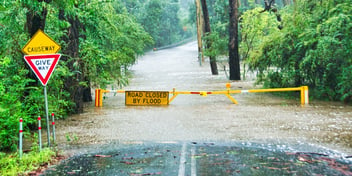Australia must tackle water risks to curb potential GDP losses

Droughts, floods and storms could result in a total loss of $452 billion to Australia’s GDP between now and 2050, according to new research from GHD that aims to identify and unlock the social and environmental benefits of tackling water risk head-on.
Aquanomics: The economics of water risk and future resilience assesses the future economic impact of water risk from extreme weather events across five industries in seven countries, including Australia, the United States, the United Kingdom, the Philippines, the United Arab Emirates, China and Canada.
The research places Australia in the third most vulnerable position when projecting the future economic impact of extreme water-related weather events, with storms expected to have the greatest direct impact on the Australian economy ($102 billion), followed by floods ($64 billion) and droughts ($41 billion).
Representing the first time the economic impact of these three types of water events have been calculated at a GDP and sector level, GHD Australian Water Market Leader Lindsey Brown said the research is an important step in shifting to a more sustainable approach to water.
“It’s time to move away from viewing water as a commodity to be controlled, and instead recognise its intrinsic value: water is part of a natural cycle, the balance of which must be restored and maintained if we are to live sustainably and prosper,” she said.
“We need to be tackling water risk head-on. And Australia needs to reorient its relationship with water.
“Having this information for the first time will enable a different discussion to happen. By putting a price on water risk at a GDP level, it allows us to come back around to a very important question: are we valuing water appropriately?”
Future focus
Aquanomics highlights the potential future impact of extreme weather events on five major economic sectors in Australia: agriculture; banking and insurance; energy and utilities; fast-moving consumer goods and retail; and manufacturing and distribution.
The report reveals that Australia’s agricultural sector is particularly vulnerable, with projected annual output losses of over 5% by 2030 and 8% by 2050.
Brown said the future focus of the Aquanomics report is important, as the figures we see around the impacts of climate change, particularly around extreme events, are usually backward looking.
“We typically get the numbers of the impact of a particular flood or storm after the fact. But it’s also really important for us to be forward looking,” she said.
“And the report spells out the expected cost to industry and our communities if we continue on with a business-as-usual approach.”
Brown said the report also clearly points out that much of today's infrastructure is built for yesterday's climate and understanding the costs involved in leaving water risks unmitigated will allow for more informed decision-making around investment.
“This new research gives us something to compare against, to trade off against, to assess value against, when we're thinking about making investments,” she said.
“If we are going to protect our communities and economy and environment from what is obviously and measurably very significant harm, we need to be taking steps to change the way that we're doing things.”
Tackling water risk
One of the key focuses of the Aquanomics report regards what can be done now to help mitigate the staggering economic losses that have been projected. Brown said GHD is advocating for effective climate adaptation and optimisation of systems, and prioritisation of more circular approaches to water management.
“Embracing the circular approach to water management is a key part of creating climate resilience in Australia. We have to get better at embracing the holistic nature of the world we're living in and the interconnectedness of water in supporting a sustainable version of that entire system,” she said.
“The economics behind these risks we are facing helps remind us that water has an impact on every sector, not just on the water sector. Collectively, water has an impact on our entire economy.
“We need to adapt the way that we do things, and the way we invest in infrastructure. This is about accepting that we are going to see more extreme events more often, and that our current infrastructure is not built for that – it's built for a much narrower climate spectrum than we're now typically seeing.”
From an adaptation point of view, Brown said Australia needs to adapt more to extremes and invest in infrastructure that caters more to those extremes, but we also need to rethink our investment avenues.
“Sometimes large scale, centralised infrastructure will be the answer. But in some cases those types of big investments can close off other options that may lead to more resilient outcomes,” she said.
“So it’s important we explore smaller, more short-term investments so that we can create a more adaptive pathway forward in the way that our infrastructure is actually rolled out.”
Brown said optimisation is the second key to mitigating water risk, but that ensuring the effective prioritisation of circular approaches to water management will also be crucial.
“We need to optimise everything that we have, including our infrastructure and digital systems. Automation and machine-learning allow us to do this, but we also need to optimise all of the water sources that we have available now,” she said.
“Effective optimisation will be central to helping us keep costs down for customers.
“But we also need to get better at prioritising regenerative, circular options for how we move ahead. Right now we see circularity of water management as part of the mix, but it needs to become the default.”
Getting circularity right
Transitioning to a circular approach to water management will not only help curb the economic impact of water risks in future, Brown said, it will also ensure that the whole society benefits – so long as it’s done right.
“When we do it right, the whole of society benefits. We must move away from thinking about water’s role as a single-use resource for us to drink, or for the environment, or for industry,” she said.
“We have a huge opportunity in front of us to derive the most value from what is a public investment.
“To do this, we need to make sure our approaches are deeply connected to context, to place – that's where we will find the opportunities and solutions. It's all about understanding water's role in driving a more sustainable world.”
Brown said that when prioritising solutions that are deeply connected to place, it’s important to acknowledge that those solutions will look different in every place.
“Every place has unique opportunities and benefits, as well as potential risks and vulnerabilities. Being connected to a place means being connected to a community. It also means being connected to Traditional Owner values,” she said.
“We have the opportunity to foster a very rich connection to place in terms of how we manage water, which will allow us to come up with the best options that will deliver the most value for everyone.”


